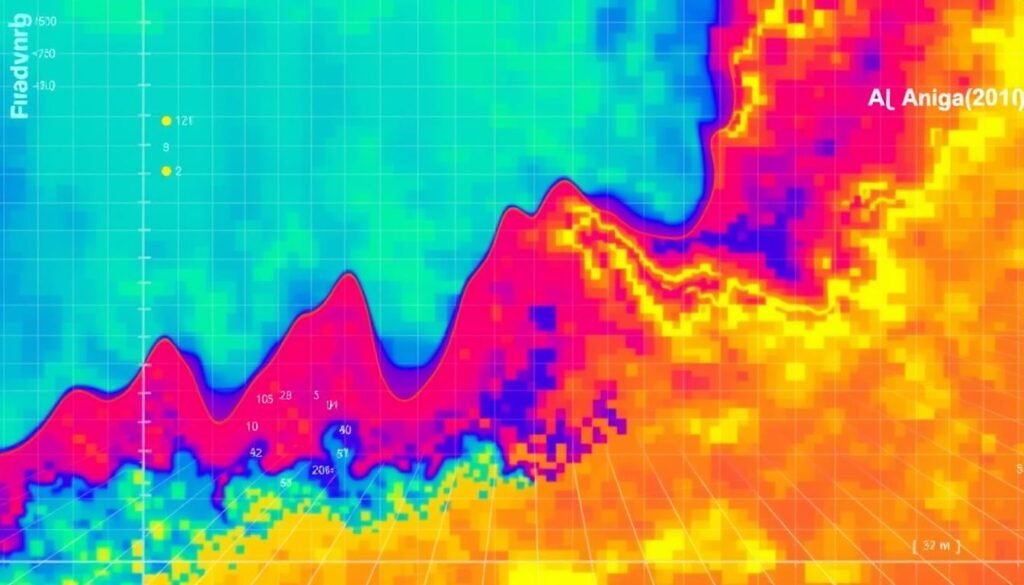In 2018, global fraud costs hit a staggering £3.89 trillion. This shows how crucial anomaly detection is across many fields. Anomaly heatmap ml systems help spot unusual data patterns, offering insights for better decision-making. These systems are key in visualizing complex data and finding trends and outliers.
Using anomaly heatmap ml systems can reveal hidden data patterns. This lets you act early to stop fraud, defects, or other problems. Heatmaps make it simple to understand large data sets. As data grows, so does the need for anomaly detection, with heatmaps leading the way.

Key Takeaways
- Anomaly heatmap ml systems are powerful tools for identifying trends and outliers in complex data sets.
- Anomaly detection heatmaps provide a compact and easily interpretable format for analyzing extensive data sets.
- Machine learning anomaly detection plays a vital role in identifying unusual patterns in data.
- Anomaly detection is crucial in various industries, including finance, manufacturing, and healthcare.
- Anomaly heatmap ml systems can help you uncover hidden patterns in your data, enabling you to take proactive measures to prevent issues.
- Heatmaps offer advantages over traditional data visualization methods, including intuitive understanding and pattern recognition.
- Anomaly detection involves gathering data, cleaning it, selecting important details, training models, and monitoring performance continuously.
Understanding Anomaly Heatmap ML Systems and Their Importance
Exploring machine learning and data analysis, you’ll find many tools and techniques. Anomaly heatmap ML systems are key in spotting unusual data points. They offer insights that are crucial for businesses.
Heatmap visualization in ml uses colors to show data values. It helps spot trends and anomalies. This way, businesses can understand their data better and make smart choices.
What Are Anomaly Heatmaps?
Anomaly heatmaps show data with color-coded systems. They help see patterns and oddities in big datasets. This makes it easier to find what’s different.
The Role of Machine Learning in Anomaly Detection
Machine learning algorithms are vital for finding anomalies. They learn from data and spot unusual patterns. This is key for businesses to stay competitive.
Key Benefits for Business Intelligence
Anomaly heatmap ML systems offer many benefits. They improve decision-making, boost efficiency, and enhance customer service. By using these tools, businesses can find areas to improve and make better choices.
- Improved decision-making
- Increased efficiency
- Enhanced customer experience
- Identifying areas that need improvement
- Making data-driven decisions
| Benefits | Description |
|---|---|
| Improved decision-making | Anomaly heatmap ML systems provide valuable insights that help businesses make informed decisions. |
| Increased efficiency | By identifying areas that need improvement, businesses can optimize their processes and increase efficiency. |
| Enhanced customer experience | Anomaly heatmap ML systems help businesses identify patterns and trends in customer behavior, leading to a better customer experience. |
The Science Behind Heat-Based Visualization in Machine Learning
Exploring machine learning, you’ll find heat-based visualization is key. It turns complex data into simple, easy-to-understand colors. This method helps data scientists spot patterns and trends, especially in identifying anomalies.
Heat-based visualization is great for showing how different variables relate to each other. It’s vital for spotting data patterns, risks, or gaps. Heat maps make it easy to see where data is dense and where it’s not.
Some benefits of heat maps include:
- Effectively visualizing data density
- Highlighting concentration areas
- Providing a quick overview of the data
In summary, heat-based visualization is a powerful tool in machine learning. It helps you find trends, share insights, and keep an eye on models. By using it for anomaly detection, you can make the most of your data and make better decisions.
| Visualization Technique | Description |
|---|---|
| Heat Maps | Display correlations between multiple variables |
| Scatter Plots | Show relationships between two variables |
| Bar Charts | Compare categorical data |
Core Components of ML-Powered Anomaly Detection
Exploring machine learning anomaly detection, it’s key to grasp its core parts. Anomaly detection heatmaps are vital for spotting rare events or observations. These are different from the usual data. The process includes collecting and cleaning data, picking the right algorithm, and training it for accurate results.
Getting and preparing data is crucial in anomaly detection. You must collect relevant data and clean it to remove errors. Then, you select and train an algorithm to spot patterns and anomalies.
Data Collection and Preprocessing
This step is about gathering data from various sources and making it accurate and consistent. Techniques like data normalization and feature scaling help prepare the data for analysis.
Algorithm Selection and Training
With the data ready, you must choose a good algorithm for anomaly detection. You can use supervised or unsupervised learning, depending on your data and problem. Algorithms like Support Vector Machine learning and K-Nearest Neighbors Classifier are popular choices.
Visualization Techniques and Tools
After training the algorithm, you need to see the results to spot anomalies and patterns. Anomaly detection heatmaps and other tools help visualize the algorithm’s output. This step is vital for finding rare events or observations.
Tools like dashboards and charts are popular for visualizing anomaly detection results. They offer insights into warnings and alerts, showing the number of each. Scheduled searches can also run at set times, like every hour, for real-time detection.
Implementing Real-Time Anomaly Detection Systems
When you think about adding real-time anomaly detection systems, it’s key to know how ai anomaly detection tools work. These tools use machine learning to spot oddities in data right away. This helps businesses act fast to avoid problems.
Real-time systems let you watch many things like website visits, sales, and support requests. This helps companies fix issues quickly and use resources wisely. Heatmap visualization in ml helps see data patterns and trends.
Setting up real-time anomaly detection involves a few steps:
- Data collection
- Data preprocessing
- Model training
- Anomaly detection
- User alert
By taking these steps and using the right ai anomaly detection tools, companies can boost customer happiness. They can also make smarter choices and run their operations better.

| Technique | Description |
|---|---|
| Supervised Anomaly Detection | Requires labeled training data for model training |
| Unsupervised Anomaly Detection | Does not need labeled datasets for model training |
| Automated Unsupervised Anomaly Detection | Involves steps such as data collection, normalization, segmentation, feature extraction, model training, anomaly score calculation, and validation |
Advanced Features of Modern Anomaly Detection Platforms
Modern anomaly detection platforms have advanced features that make them better at finding anomalies. They use anomaly detection algorithms and ml systems for anomaly identification to spot complex data patterns. Pattern recognition is a key feature, allowing the platform to find detailed patterns that might show an anomaly.
Automated alert systems are another important feature. They send alerts in real-time when an anomaly is found. This helps take action quickly to prevent damage. Integration options are also key, making it easy to work with other systems to handle anomalies. Some platforms even use machine learning to improve how well they detect anomalies.
Some notable examples of advanced features include:
- Long Short-Term Memory (LSTM) networks and Convolutional Neural Networks (CNNs) for anomaly detection tasks
- Evaluation metrics such as precision, recall, and F1 score to assess anomaly detection models’ accuracy and robustness
- Neural network-based anomaly detection models that demonstrate effectiveness in detecting anomalies in multivariate time series data
Anomaly detection systems can find both known and unknown attacks or malicious behaviors. Logs are very important for finding anomalies in networks. The use of anomaly detection algorithms and ml systems for anomaly identification has shown great results in spotting anomalies in network traffic.
Maximizing ROI Through Predictive Analytics
Predictive analytics is a powerful tool for boosting ROI. It uses predictive analytics anomaly detection to spot trends and patterns in data. This makes it easier to forecast what will happen next. Anomaly heatmap ml systems help find odd data points, giving valuable insights.
Some key benefits of using predictive analytics include:
- Identifying trends and patterns in data
- Predicting future outcomes
- Making informed decisions
- Maximizing ROI
Companies like KONE, a Finnish industrial company, have seen big improvements. They used predictive analytics to boost their operations. By combining cognitive tech, IoT, and advanced analytics, KONE can now predict when equipment might fail. They then suggest actions to prevent or fix issues.

To get the most out of predictive analytics anomaly detection, businesses can try different methods. These include:
- Data preparation
- Model building
- Training
- Testing
- Validation
| Technique | Description |
|---|---|
| Data Preparation | Collecting and preprocessing data |
| Model Building | Creating predictive models using machine learning algorithms |
| Training | Training the model using historical data |
| Testing | Testing the model using new data |
| Validation | Validating the model using evaluation metrics |
By employing anomaly heatmap ml systems and predictive analytics anomaly detection, businesses can make better choices. This leads to higher ROI and keeps them competitive.
Best Practices for Deploying Heatmap-Based ML Solutions
When you deploy heatmap-based ML solutions, focus on data quality and system optimization. This ensures accurate results. Anomaly detection heatmaps are key in machine learning, showing complex data patterns and trends. By following best practices, you can fully use heatmap-based ML solutions and get valuable insights.
First, understand the importance of data quality in heatmap-based ML solutions. Bad data quality can lead to wrong results, affecting business decisions. Make sure your data is clean, complete, and consistent. This way, you can trust the insights from your heatmap-based ML solutions.
Data Quality Management
Data quality management includes data preprocessing, validation, and normalization. These steps ensure your data is accurate and reliable. Also, consider data governance policies for secure handling and storage of your data.
System Optimization Tips
Optimizing your system is crucial for heatmap-based ML solutions. Choose the right algorithm and tune hyperparameters for better performance. This improves the accuracy and efficiency of your anomaly detection heatmaps. Use the right data visualization tools, configure for real-time data, and monitor performance regularly.
By following these best practices, you can fully use heatmap-based ML solutions. Anomaly detection heatmaps are powerful in machine learning. Deploying them well can enhance your business intelligence and decision-making.
| Best Practice | Description |
|---|---|
| Data Quality Management | Ensure that your data is clean, complete, and consistent |
| System Optimization | Select the right algorithm and tune hyperparameters for improved performance |
| Performance Monitoring | Monitor your system’s performance regularly to identify areas for improvement |
Conclusion: Transforming Data Analysis with Intelligent Anomaly Detection
The digital world keeps changing, making smart anomaly detection more crucial than ever. Anomaly heatmap ML systems help find trends and oddities in big data. This leads to better choices for businesses. Using AI for anomaly detection gives you key insights to improve operations and stay ahead.
Combining anomaly heatmaps with machine learning has changed data analysis for companies. It lets you spot oddities fast, helping you tackle problems quickly. This means less time wasted and more opportunities for growth.
Using anomaly heatmap ML systems and AI tools changes how you analyze data. You can see patterns and oddities that were hidden before. This knowledge helps you make smarter decisions, leading to success in today’s fast-paced market.
FAQ
What are anomaly heatmaps?
Anomaly heatmaps show data with colors. They help spot patterns and trends. They also find unusual data points.
How do machine learning algorithms play a role in anomaly detection?
Machine learning algorithms are key in finding anomalies. They learn from data and spot unusual patterns.
What are the key benefits of anomaly heatmap ML systems for business intelligence?
Anomaly heatmap ML systems help businesses make better decisions. They also make work more efficient and improve customer service.
What are the core components of ML-powered anomaly detection?
ML-powered anomaly detection includes several parts. These are data collection and prep, choosing and training algorithms, and using visualization tools.
Why is implementing real-time anomaly detection systems crucial?
Real-time anomaly detection systems are vital. They catch anomalies as they happen. This gives businesses quick insights and helps them act fast.
What are the advanced features of modern anomaly detection platforms?
Modern platforms have cool features. They can recognize patterns, send alerts automatically, and connect with other systems. These make them better at finding anomalies.
How can predictive analytics and anomaly heatmap ML systems be used to maximize ROI?
Predictive analytics and ML systems help find trends and patterns. This makes it easier to predict the future. It helps businesses get the most out of their investments.
What are some best practices for deploying heatmap-based ML solutions?
To deploy ML solutions well, focus on data quality and system optimization. Also, keep an eye on how they perform.
Also Read
Knowledge Graph AI Optimization
